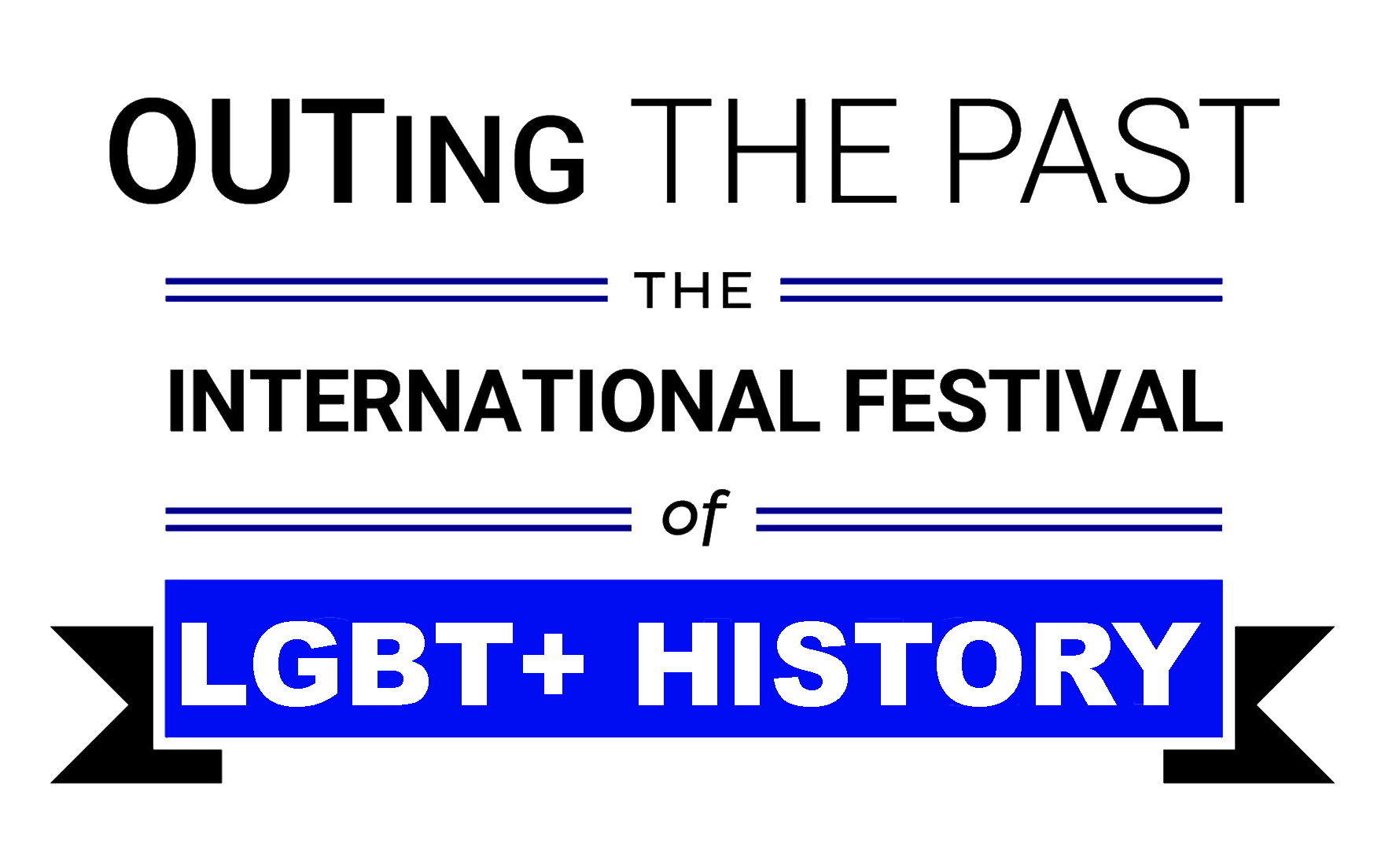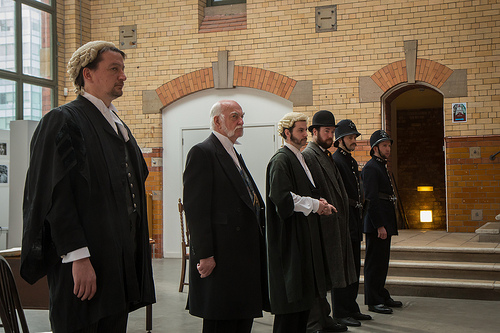Festival Theatre 2015: “A Very Victorian Scandal”
Stephen M Hornby, our National Festival Theatre Coordinator, continues his cataloguing of Festival Theatre with a look at the first example, “A Very Victorian Scandal”.
MATT WAINWRIGHT, TOM KUZNIAR AND THOMAS PECK (LEFT TO RIGHT) AS THE CAN-CAN BOYS SURROUND DAN WALLACE AS KITTY HEARTSTONE (CENTRE)
“A Very Victorian Scandal” (“AVVS”) was based on the events surrounding the largest raid on an LGBT venue in UK history. It has been christened “The UK’s Stoneweall”, and yet it happened nearly ninety years earlier in September 1880. The Manchester Police has been given information that a group of men were hiring a Temperance Hall in Hulme for the purposes of holding an all male fancy dress ball. The men had taken every opprotunity to disguise their intent, hiring the venue in the name of the Assistant Pawnbrookers of Manchester, covering over the windows and hiring a blind accordian player. Manchester’s leading detective, Jerome Caminada, however, was determined to arrest the men for sexual offences and raided the venue in the early hours, as some of the men started to leave. The resulting trial caused a national sensation, a scandal that emboided the hypocritical values of the Victorian era, and shook Manchester’s establishment to it’s core.
Jeff Evans, the project’s historical adviser, provided new historical material showing two sets of census data on all the men who were arrested and a wealth of press cuttings reporting the raid and subsequent progress of the case through the courts. Ric Brady and I reviewed this rich primary material and knew we had almost an embarrasment of riches in terms of what had dramatic protential. Our commission from LGBT History Month was to dramatise the story into a set of performances that would take place during the first national festvial of LGBT History from 13-15 February 2015.
JOHN SMEATHERS AS THE EMCEE AND ALAN BECK AS SISTER MERCY (LEFT TO RIGHT)
We proposed three short plays, which could be enjoyed as stand alone pieces, as well as collectively. One piece would be a reconstruction of the likely entertainments that happened at the ball and would lead into a reconstruction of the raid itself (“AVVS: The Raid”). One piece would deal with the press reporting of the case (“AVVS: The Press”), and the final piece would deal with the trial of the men who were arrested (“AVVS: The Trial”).
We were delighted to secure funding for the project from the Arts Council of England and from our patron Russell T Davies, but as the project was greenlit, we started to have to face some problems:
“AVVS: The Trial” was originally conceived of as an immersive piece that took place in extant Victorian Police cells and a Court. The practical difficulties of repeat it as part of a wider festival were impossible and meant that a new venue was needed. This also meant a refocus just on the trial itself and away from the immersive one-to-one elements.
The Temperance Hall where the original raid took place no longer existed. So, a substitute venue was needed. It then became clear that both an emcee character and some narrative and dialogue would be required for the characters who were at the raid and would then appear in the other two pieces.
The relationship between the press and the police contained a lot of circumstantial evidence for a level of collusion between the two and how this impacted on the trial, but there was no “smoking gun” in the documentary evidence to prove anything.
MARTIN GREEN AS MR COBBETT, JOHN SMEATHERS AS MAGISTRATE RICKARDS, GRAHAM EAGLESHAM AS MR NASH, MARK ROBERTS AS JEROME CAMINADA AND TWO CONSTABLES (GARETH GEORGE AND DAN JARVIS) (LEFT TO RIGHT)
One of the main sites for the festival was the People’s History Museum, the national museum of democracy. The museum has a wonderful engine hall, with huge Victorian windows that look out on to the Manchester Civil Justuce Centre. Suddenly, we realised we had the venue for “AVVS: The Trial”. Whilst the site of the Temperance Hall had long been tarmaced over, there was a modern equivalent in Canal Street itself. The largest and most famous venue in the Gay Village, Via, welcomed us in to stage “AVVS: The Raid”. And the problem of the bridging historical record and historical speculation was solved with the invention of Henry Newman. The Manchester Central Library was another venue for the festival and it’s performance space has large arched windows that look out over the red stone facade of the Midland Hotel, which is mentioned by Detective Camiada in his memoirs. We had found the perfect venue for “AVVS: The Press”, one again right under our noses.
Subsequent blogs on each of the separate elements of “A Very Victorian Scandal” will give more fascinating insights into the writing and production process.
THE MAIN POSTER FOR THE TRILOGY FEATURING DAN WALLACE AS KITTY HEARTSTONE
Photo credits: Nicolas Chinardet (except poster Daniel Mee)




